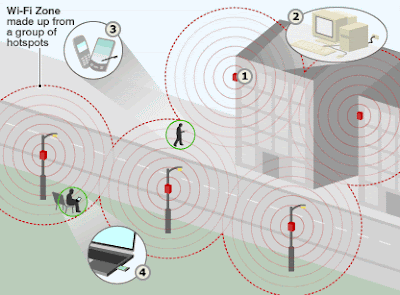A wireless access point (WAP) connects a group of wireless devices to an adjacent wired LAN. An access point resembles a network hub, relaying data between connected wireless devices in addition to a (usually) single connected wired device, most often an Ethernet hub or switch, allowing wireless devices to communicate with other wired devices.
Wireless adapters allow devices to connect to a wireless network. These adapters connect to devices using various external or internal interconnects such as PCI, miniPCI, USB, ExpressCard, Cardbus and PC Card. As of 2010, most newer laptop computers come equipped with built in internal adapters.
Wireless routers integrate a Wireless Access Point, Ethernet switch, and internal router firmware application that provides IP routing, NAT, andDNS forwarding through an integrated WAN-interface. A wireless router allows wired and wireless Ethernet LAN devices to connect to a (usually) single WAN device such as a cable modem or a DSL modem. A wireless router allows all three devices, mainly the access point and router, to be configured through one central utility. This utility is usually an integrated web server that is accessible to wired and wireless LAN clients and often optionally to WAN clients. This utility may also be an application that is run on a computer, as is the case with as Apple's AirPort, which is managed with the AirPort Utility on Mac OS X and iOS.
Wireless network bridges connect a wired network to a wireless network. A bridge differs from an access point: an access point connects wireless devices to a wired network at the data-link layer. Two wireless bridges may be used to connect two wired networks over a wireless link, useful in situations where a wired connection may be unavailable, such as between two separate homes.
Wireless range-extenders or wireless repeaters can extend the range of an existing wireless network. Strategically placed range-extenders can elongate a signal area or allow for the signal area to reach around barriers such as those pertaining in L-shaped corridors. Wireless devices connected through repeaters will suffer from an increased latency for each hop, as well as from a reduction in the maximum data throughput that is available. In addition, the effect of additional users using a network employing wireless range-extenders is to consume the available bandwidth faster than would be the case where but a single user migrates around a network employing extenders. For this reason, wireless range-extenders work best in networks supporting very low traffic throughput requirements, such as for cases where but a single user with a Wi-Fi equipped tablet migrates around the combined extended and non-extended portions of the total connected network. Additionally, a wireless device connected to any of the repeaters in the chain will have a data throughput that is also limited by the "weakest link" existing in the chain between where the connection originates and where the connection ends. Networks employing wireless extenders are also more prone to degradation from interference from neighboring access points that border portions of the extended network and that happen to occupy the same channel as the extended network.
The security standard, Wi-Fi Protected Setup, allows embedded devices with limited graphical user interface to connect to the Internet with ease. Wi-Fi Protected Setup has 2 configurations: The Push Button configuration and the PIN configuration. These embedded devices are also called The Internet of Things and are low-power, battery-operated embedded systems. A number of Wi-Fi manufacturers design chips and modules for embedded Wi-Fi, such as GainSpan.









